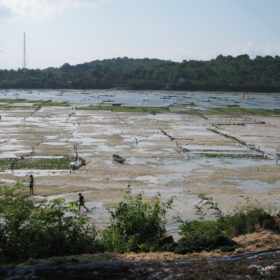
An EU funded solar-plus-storage project has been tendered in the Philippines. The United Nations is seeking bids for the system, to support the for the seaweed industry on the island of Tawi-Tawi. Combining PV with aquaculture brings many advantages for both, including water conservation, a more controlled aquatic environment, and ecosystem restoration.
The United Nations Industrial Development Organization (UNIDO) is seeking to support the seaweed industry on the Philippine island of Tawi-Tawi, located in the Bangsamoro Autonomous Region in Muslim Mindanao (BARMM), at the southernmost frontier of the country.
In this regard, the organization is bringing more electricity to one of the least electrified areas of the archipelago, with solar-plus-storage chosen as the cheapest and most efficient source. UNIDO has now kicked off a tender through an EU funded project named Renewable Energy Technology to Increase Value Added of Seaweeds in Tawi-Tawi (RETS).
The international organization is seeking solar PV and storage to operate as a hybrid system with diesel generators for additional power supply in the island municipalities of Sitangkai and Sibutu, where many seaweed farms are located. Interested developers have until September 9 to submit bids.
Thy hybrid systems will be owned and operated by local utility Tawi-Tawi Electric Cooperative, Inc. in fulfilment of its mandated obligation to provide total electrification in its area of operations, according to the Mindanao Development Authority (MinDA). Currently, only around 30% of the island’s households have access to electricity. The island is the largest seaweed supplier in the Philippines, accounting for 70% of total production.
Mutual benefits
According to the study Aquavoltaics: Synergies for Dual Use of Water Area for Solar Photovoltaic Electricity Generation and Aquaculture, published in 2017 in Renewable and Sustainable Energy Reviews, there is a wide range of potential benefits to combining the two technologies. “While reservoirs benefit greatly from water conservation, implementing an aquaculture system in a reservoir is an attractive prospect for efficient land use”, they stated.
Another benefit is a more controlled aquatic environment. The scientists claim that, by monitoring growth factors such as nutrients, temperature, pH, salinity, turbidity and photoperiod, the aquaculture can have ideal growth conditions for particular aquatic organisms for various locations be they warm or cool water cultures. “PV-powered water pumping systems could also be employed to manipulate oxygenation zones, which form at different levels in bodies of water,” the report notes.
Furthermore, the combination of PV and aquaculture is said to be good for ecosystem restoration. As energy demand is a barrier for growth of the industry, farmers tend to concentrate in the same areas, which has a negative impact on production and quality, as well as on the surrounding aquatic ecosystem. “If the energy requirements are met or exceeded with solar technology, which has the potential to leave the grid, then it allows commercial-scale aquaculture farms to be built anywhere there is sufficient sunlight,” the experts also affirmed. According to them, the habitat created by these dual use systems would even encourage the reemergence of endangered species.
“One of the largest unknowns is the interaction of floating PV with aquatic organisms and the potential for biofouling to occur,” they concluded.
Lắp đặt điện mặt trời Khải Minh Tech
https://ift.tt/2X7bF6x
0906633505
info.khaiminhtech@gmail.com
80/39 Trần Quang Diệu, Phường 14, Quận 3
Lắp đặt điện mặt trời Khải Minh Tech
https://ift.tt/2ZH4TRU
Không có nhận xét nào:
Đăng nhận xét